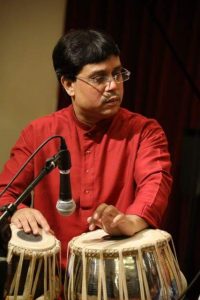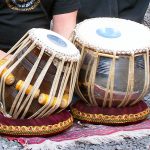Concert Details and Tickets for Musical Passions
Return to Engaging with the Orchestra

Jyoti Prakas
Jyoti Prakas began his musical career at childhood from his father, Sri Nagendranath, and later with Pandit Brojen Biswas and Sri Sumantra Guha. As his passion and experience playing tabla progressed, he came under the tutelage of Pandit Abhijit Banerjee, one of the most renowned tabla players in India today.
Jyoti Prakas has performed extensively in India and United States, and in the presence of Sitar maestro – Pt. Ravi Shankar and highly acclaimed Hindustani vocalist—Vidushi Girija Devi. He has accompanied various internationally acclaimed musicians like, Pt. Jasraj, Ustaad Saheed Parvez,Vidushi Purnima Chowdhury, and Viraj Amar on vocal, Pt. Keshav Ginde on flute, Pt. .K.Sidhar on sarod, Pt. Tarun Bhattachrya on Santoor, Kathak Dancer Pt. Chitresh Das, Tap Dancer Jason Samuel Smith, just to name a few. He has also played tabla in the prestigious “EMMY AWARD 2005.”
He has participated in community programs organized by the San Diego Museum and delivered lecture demonstrations in La Jolla Elementary School, San Diego, Whittier College, Whittier, and Concordia University, Irvine. Jyoti Prakas has also performed at Drum Festival at University of Riverside, California. Jyoti Prakas has worked as an Assistant Music Director for a telefilm on Child Psychology for Kolkata Television. He has performed in All India Radio and Television, conducted workshops in West Bengal, India and also been on the panel of judges for various music competitions arranged by University of Calcutta, India. He has taught for several years in various institutions in India, and has been teaching since 2004 at Southern California Chapter of the prestigious music school DHWANI ACADEMY OF PERCUSSION MUSIC, founded by Pandit Abhijit Banerjee.
-from Jyoti Prakas website
About the Tabla
The tabla is a membranophone percussion instrument originating from the Indian subcontinent, consisting of a pair of drums, used in traditional, classical, popular and folk music. It has been a particularly important instrument in Hindustani classical music since the 18th century, and remains in use in India, Pakistan, Afghanistan, Nepal, Bangladesh, and Sri Lanka. The name tabla likely comes from tabl, the Persian and Arabic word for drum. However, the ultimate origin of the musical instrument is contested by scholars, some tracing it to West Asia, others tracing it to the evolution of indigenous musical instruments of the Indian subcontinent.The tabla consists of two single headed, barrel shaped small drums of slightly different size and shapes: daya also called dahina meaning right (also called “tabla”), and baya also called bahina meaning left (also called “dagga”). The daya tabla is played by the musician’s right hand (dominant hand), and is about 15 centimetres (~6 in) in diameter and 25 centimetres (~10 in) high. The baya tabla is a bit bigger and deep kettledrum shaped, about 20 centimetres (~8 in) in diameter and 25 centimetres (~10 in) in height. Each is made of hollowed out wood or clay or brass, the daya drum laced with hoops, thongs and wooden dowels on its sides. The dowels and hoops are used to tighten the tension of the membrane. The daya is tuned to the ground note of the raga called Sa (tonic in India music). The baya construction and tuning is about a fifth to an octave below that of the daya drum. The musician uses his hand’s heel pressure to change the pitch and tone colour of each drum during a performance.
The playing technique is complex and involves extensive use of the fingers and palms in various configurations to create a wide variety of different sounds and rhythms, reflected in mnemonic syllables (bol). In the Hindustani style tabla is played in two ways: band bol and khula bol. In the sense of classical music it is termed “tali” and “khali”. It is one of the main qawali instrument used by Sufi musicians of Bangladesh, Pakistan and India. The tabla is also an important instrument in the bhakti devotional traditions of Hinduism and Sikhism, such as during bhajan and kirtan singing.
-from Wikipedia
Video of Jyoti Prakas performing on the Tabla
